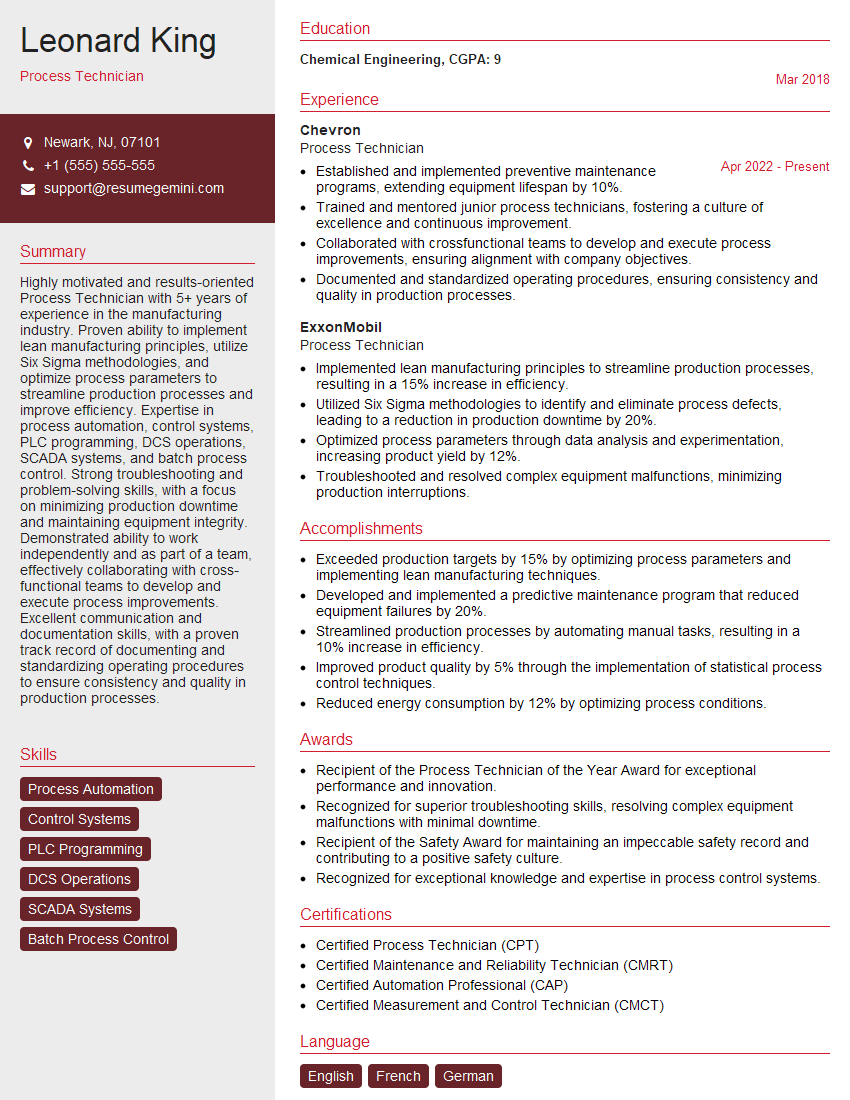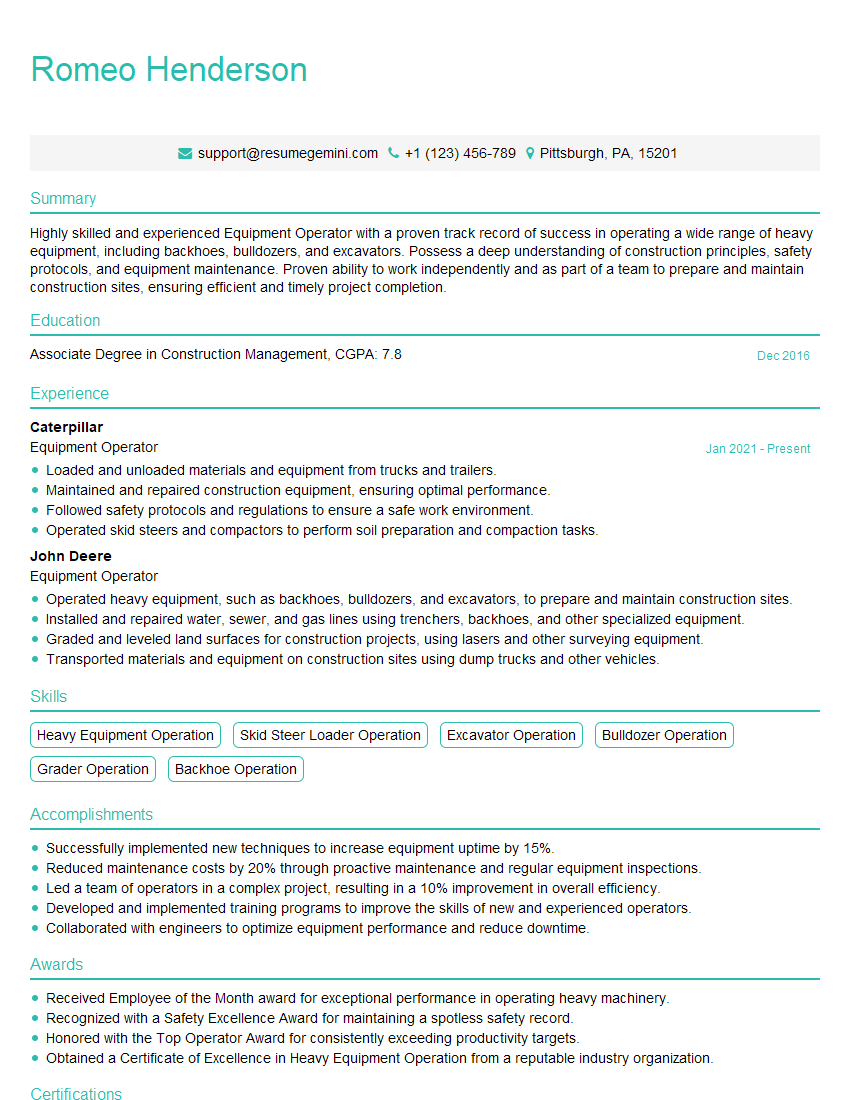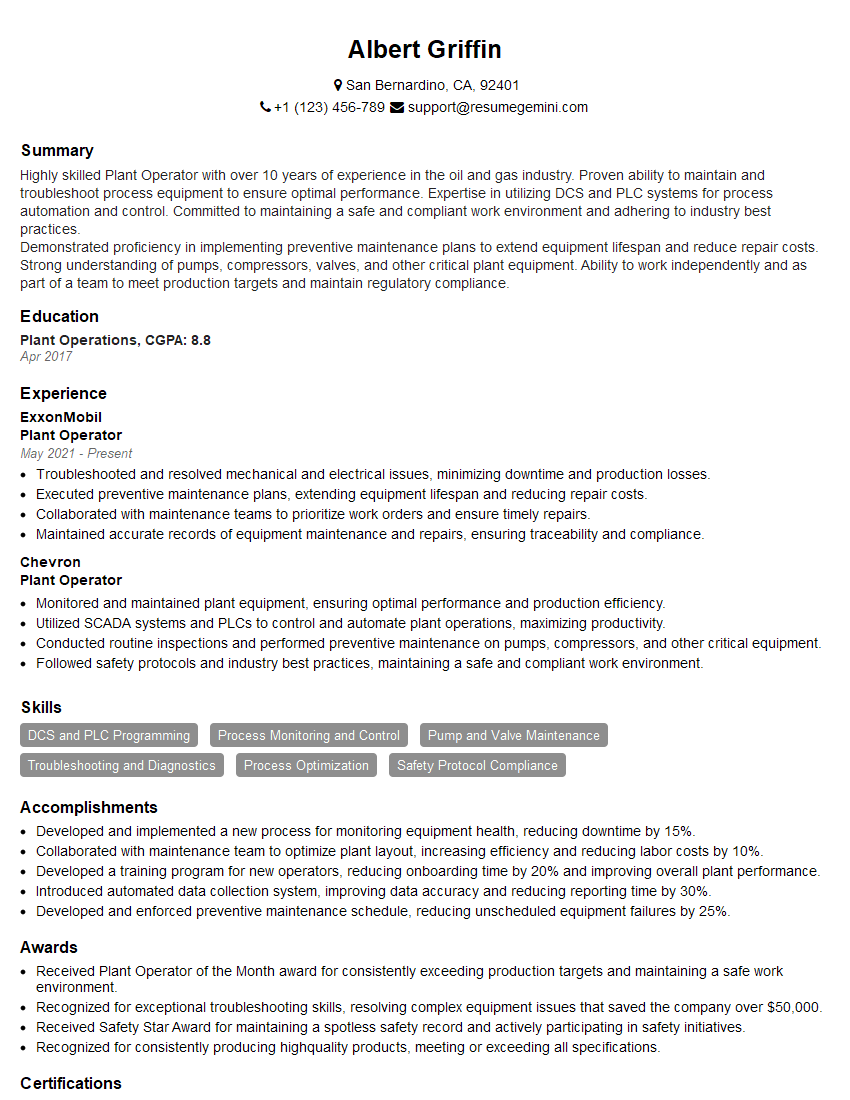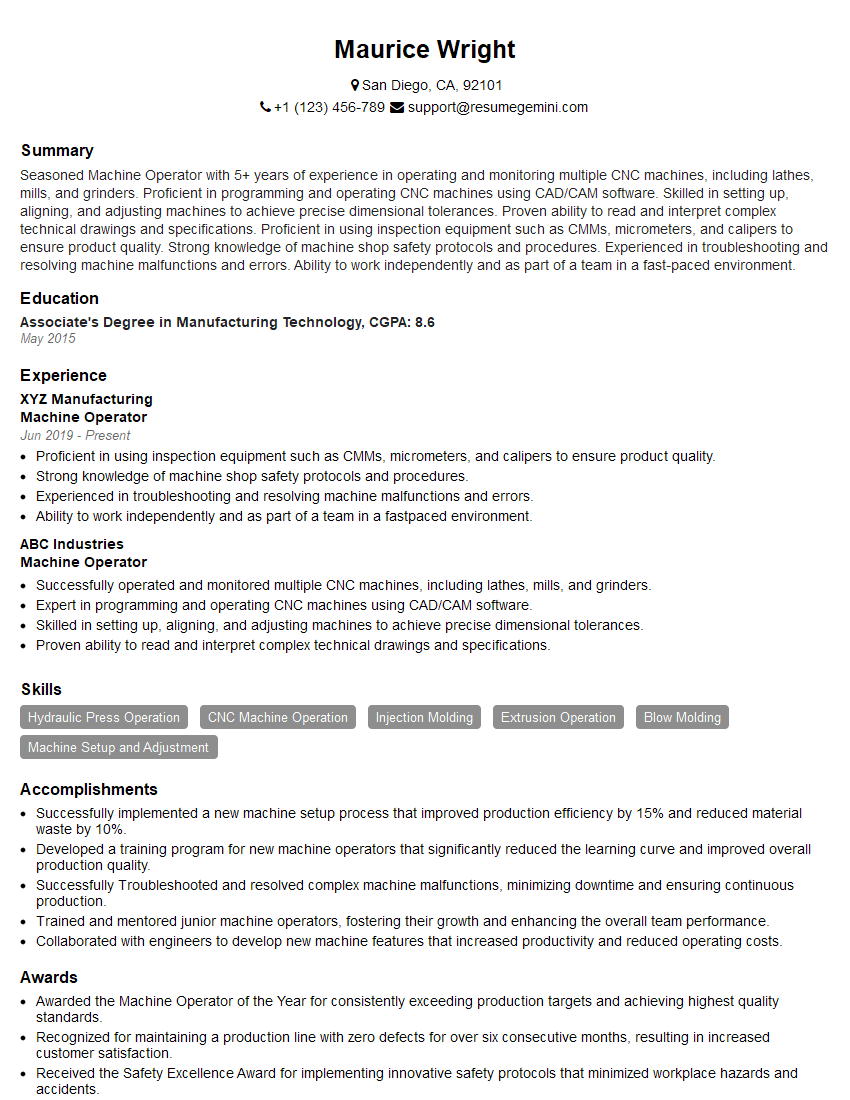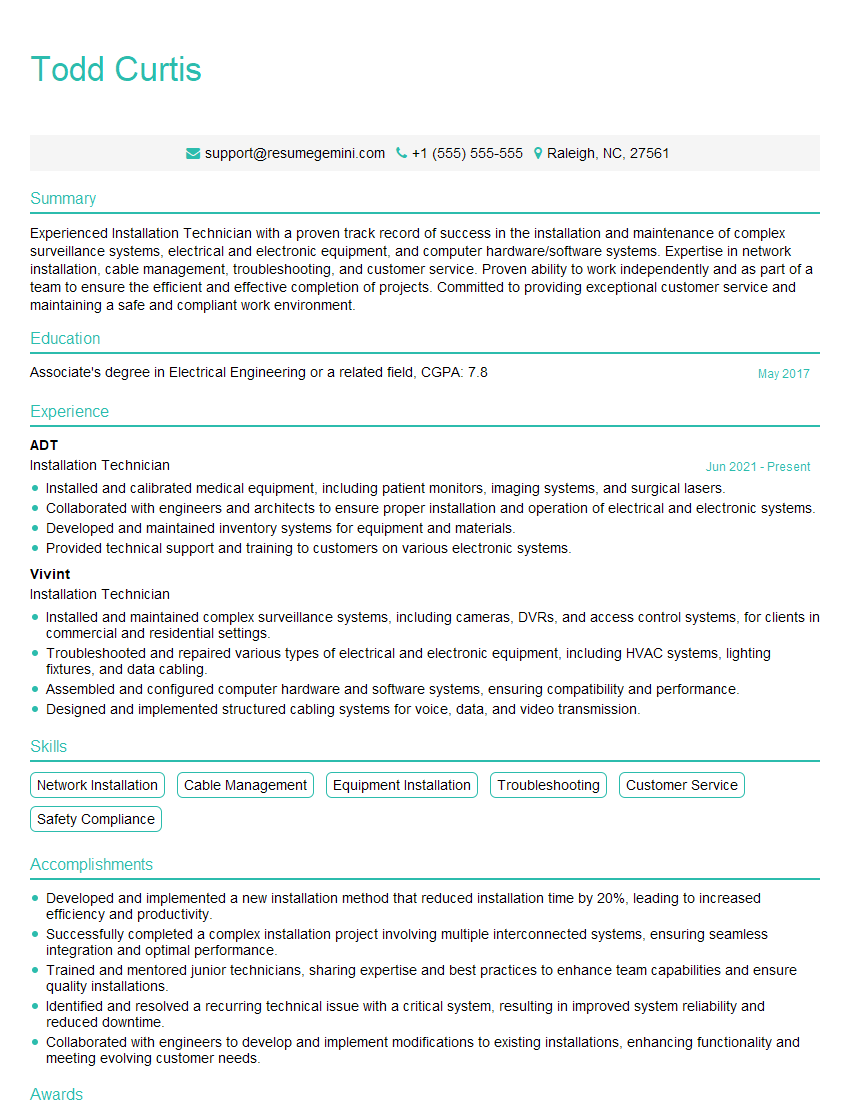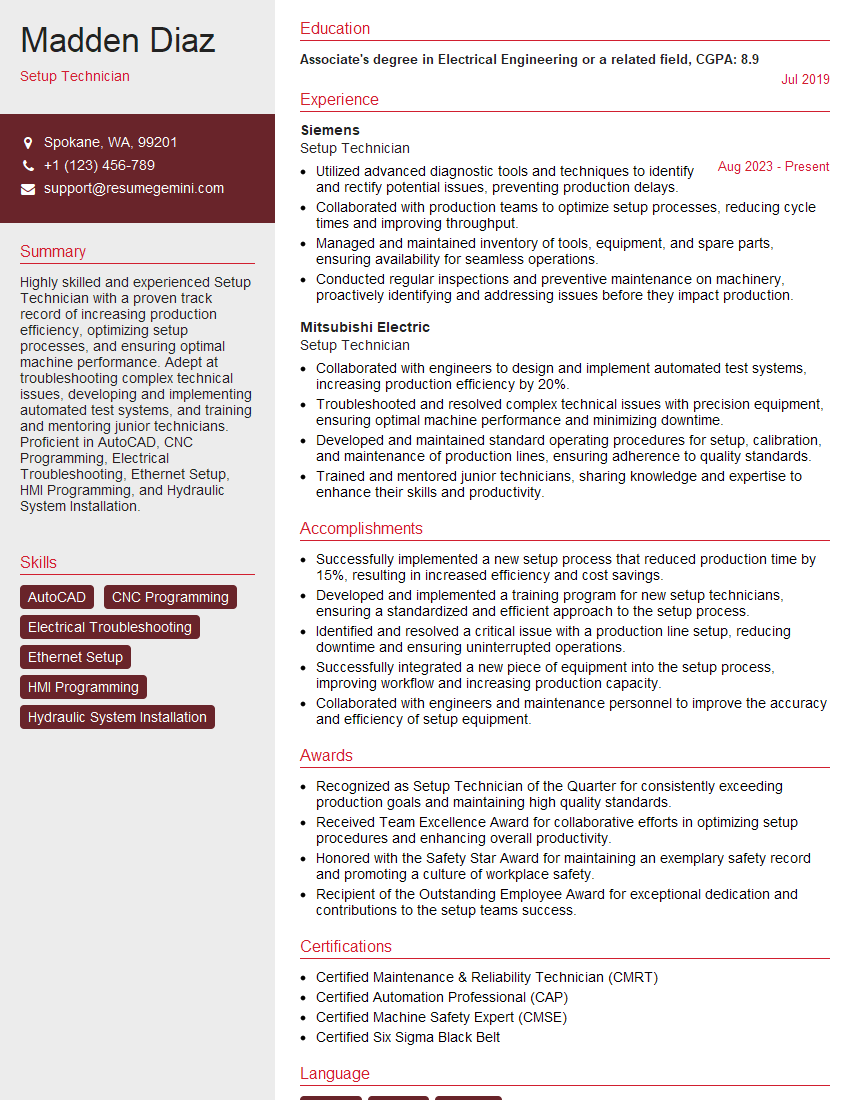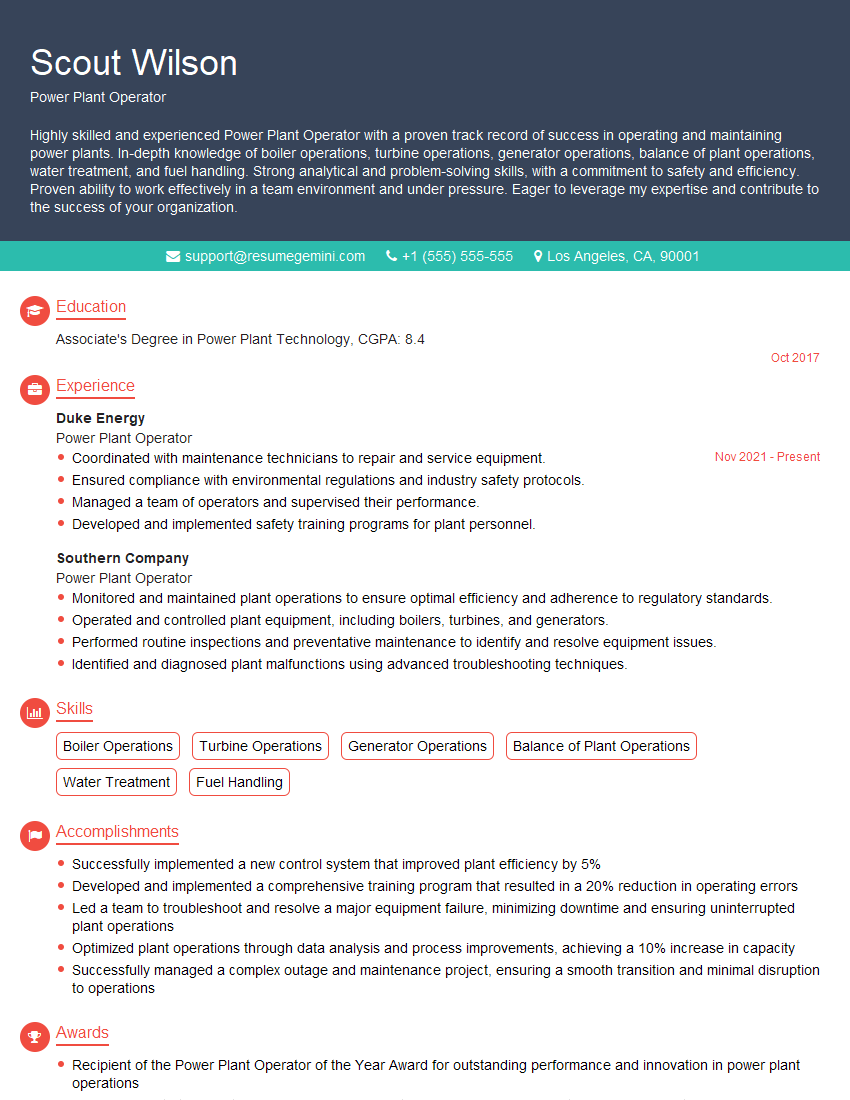Cracking a skill-specific interview, like one for Equipment Operation and Setup, requires understanding the nuances of the role. In this blog, we present the questions you’re most likely to encounter, along with insights into how to answer them effectively. Let’s ensure you’re ready to make a strong impression.
Questions Asked in Equipment Operation and Setup Interview
Q 1. Describe your experience with preventative maintenance procedures.
Preventative maintenance is crucial for ensuring equipment longevity and preventing costly breakdowns. My approach involves a structured system combining scheduled maintenance with condition-based monitoring. Scheduled maintenance follows manufacturer recommendations, including regular lubrication, cleaning, and inspections of critical components. For instance, on a CNC milling machine, this would involve checking coolant levels, lubricating moving parts, and inspecting for wear on cutting tools. Condition-based monitoring, however, goes beyond a fixed schedule. I use techniques like vibration analysis and thermal imaging to detect early signs of wear or malfunction. If vibration readings on a pump exceed a pre-defined threshold, it signals a potential bearing issue, triggering immediate investigation and potentially preventing a catastrophic failure.
- Scheduled Maintenance Log: I meticulously maintain a log detailing all scheduled maintenance activities, including dates, performed tasks, and any findings. This allows for tracking trends and identifying potential issues before they escalate.
- Condition-Based Monitoring Tools: I am proficient in using various diagnostic tools, such as vibration analyzers and thermal cameras, to monitor equipment health and predict potential problems.
Q 2. Explain the process of troubleshooting malfunctioning equipment.
Troubleshooting malfunctioning equipment involves a systematic approach. It starts with a thorough assessment of the problem, gathering information on the nature of the malfunction, when it started, and any preceding events. Think of it like diagnosing a medical condition – you need a detailed history before you can prescribe a solution. I use a logical troubleshooting process, which often involves:
- Safety First: Always prioritize safety. Isolate the equipment, lock out and tag out power sources if necessary, and wear appropriate personal protective equipment (PPE).
- Gather Information: Note any error messages, unusual sounds, or visual indicators. Interview operators to understand the context of the failure.
- Check the Obvious: Simple issues, such as power supply, loose connections, or clogged filters, are frequently overlooked. Address these first.
- Consult Documentation: Refer to manuals, schematics, and troubleshooting guides for the specific equipment. Many machines have diagnostic codes that point directly to the problem.
- Systematic Testing: If the issue isn’t immediately apparent, perform systematic checks of individual components. This might involve checking sensors, actuators, control circuits, or hydraulic/pneumatic systems, using multimeters or other diagnostic tools.
- Escalation: If the problem persists after following these steps, I escalate it to a senior technician or maintenance manager.
For example, if a conveyor belt stops unexpectedly, I’d first check the power supply, then inspect the belt for damage, followed by an examination of the drive motor and associated sensors. I would document each step and my findings.
Q 3. How do you ensure equipment is set up according to safety regulations?
Safety is paramount. Ensuring equipment is set up according to safety regulations involves several key steps. Before any equipment is even turned on, I conduct a thorough pre-operational safety check, adhering strictly to the manufacturer’s instructions and relevant safety standards. This includes verifying the correct installation of safety guards, emergency stops, and lockout/tagout procedures are in place. For example, before operating a forklift, I check tire pressure, fluid levels, and the functionality of the horn, brakes, and safety lights. Further, I make sure the area around the equipment is clear of obstructions and potential hazards.
- Lockout/Tagout Procedures: Before performing maintenance or repair work, I always follow strict lockout/tagout procedures to prevent accidental start-up.
- Personal Protective Equipment (PPE): I always wear appropriate PPE, such as safety glasses, gloves, hearing protection, and steel-toe boots, as needed based on the equipment and task.
- Regular Inspections: Regularly inspect equipment for wear and tear, and ensure safety features are functioning correctly. Any deficiencies are immediately reported and rectified.
Q 4. What are your methods for optimizing equipment performance?
Optimizing equipment performance involves a multi-faceted approach. It’s about maximizing efficiency, minimizing downtime, and extending the lifespan of the equipment. This includes regular preventative maintenance (as described earlier), but also focuses on operational adjustments and process improvements. For instance, regularly checking and adjusting cutting tool parameters on a CNC machine will enhance efficiency and precision, improving part quality and minimizing waste. Similarly, analyzing production data to identify bottlenecks and inefficiencies in the process allows targeted adjustments to optimize overall output.
- Data Analysis: I use data from equipment sensors and production monitoring systems to identify areas for improvement. This might involve analyzing cycle times, energy consumption, or material usage.
- Operator Training: Well-trained operators are key to efficient equipment operation. Regular training programs focused on best practices and safety protocols enhance overall performance.
- Process Improvements: Identifying and eliminating bottlenecks in the production process is crucial. This might involve streamlining workflows, improving material handling, or optimizing machine settings.
Q 5. Describe your experience with different types of equipment.
Throughout my career, I’ve gained extensive experience operating and setting up a variety of equipment. This includes heavy machinery such as forklifts, excavators, and cranes, as well as industrial machinery like CNC milling machines, lathes, and welding equipment. I’ve also worked with automated systems, including robotic arms and conveyor systems, and have experience with various types of pumps, compressors, and HVAC systems. Each type of equipment has its own unique operating procedures, safety protocols, and maintenance requirements, and I’ve adapted my skills to operate and maintain them efficiently and safely. My experience extends to both preventative and corrective maintenance.
Q 6. How do you handle unexpected equipment failures?
Unexpected equipment failures require a calm and systematic response. The first step is always to ensure the safety of personnel and to prevent further damage. This usually involves isolating the equipment and implementing lockout/tagout procedures. Then, I follow the troubleshooting steps described earlier. If the problem cannot be solved immediately, I’ll implement a contingency plan – which might involve using backup equipment, adjusting production schedules, or contacting external support, depending on the severity and nature of the failure. Accurate record-keeping of the failure, its impact, and the corrective actions taken is essential for future preventative measures and to avoid similar failures. A thorough post-failure analysis helps prevent recurrence of the same or similar issue.
Q 7. What safety protocols do you follow when operating equipment?
Safety protocols are ingrained in my operational practices. Before operating any equipment, I always perform a pre-operational inspection. This includes checking for any visible damage, verifying the proper functioning of all safety devices, and ensuring the work area is clear of hazards. During operation, I adhere strictly to the manufacturer’s operating instructions and follow all company safety guidelines. I am always mindful of my surroundings and the potential hazards associated with the equipment and the tasks being performed. Personal protective equipment (PPE) is worn as required, and emergency procedures are understood and readily available. Regular safety training keeps me informed on best practices and updates on safety regulations. I always report any near-miss incidents or unsafe conditions to my supervisor.
Q 8. How do you interpret technical manuals and diagrams?
Interpreting technical manuals and diagrams is crucial for safe and efficient equipment operation. I approach this systematically. First, I skim the document to understand the overall structure and content, identifying sections like safety precautions, operational procedures, and troubleshooting guides. Then, I carefully read each section, paying close attention to diagrams and schematics. I use a combination of techniques: I look for visual cues like arrows and labels in diagrams to understand the flow of processes or components. For complex diagrams, I might break it down into smaller parts to understand individual elements before understanding the whole system. I also look for any tables, charts, or flowcharts that summarize key information concisely. For example, when setting up a new CNC machine, I’ll thoroughly study the wiring diagrams to ensure correct connections before powering it up, preventing potential electrical hazards. Finally, I always cross-reference information from different sections to ensure a complete understanding of the equipment’s operation and limitations.
Q 9. Describe your experience with calibration and testing procedures.
Calibration and testing are paramount to maintaining equipment accuracy and reliability. My experience spans various instruments and methodologies. For instance, while working with analytical balances, I’ve used standard weights to calibrate them regularly, meticulously recording each weight’s reading and any deviations from the expected values. I’ve also conducted pressure and temperature calibrations on various sensors using calibrated equipment. In each case, I follow a strict procedure, documenting every step, the equipment used, and the results obtained. For instance, a deviation beyond the acceptable tolerance requires immediate investigation – is it due to a faulty sensor or a procedural error? If it’s a procedural error, I review my process to identify the problem; if the sensor is faulty, I initiate the repair or replacement process. I ensure all calibration records meet regulatory requirements and are stored securely for easy access during audits.
Q 10. How do you maintain accurate records of equipment operation?
Maintaining accurate equipment operation records is essential for traceability, troubleshooting, and regulatory compliance. I utilize a combination of methods. Primarily, I employ digital logbooks, using specialized software designed for equipment maintenance and operation, entering data like timestamps, operational parameters, maintenance performed, and any anomalies observed. I also use barcodes or QR codes linked to specific equipment and maintenance tasks to streamline the logging process. For example, each time I operate a specific piece of equipment, I scan the barcode, and the system automatically populates some fields. This minimizes manual data entry and reduces human error. Paper-based logs are only used as backup in case of digital system failure. Regardless of the method, I ensure all records are legible, complete, and stored securely. This ensures I can easily retrieve relevant data when needed, whether for regulatory compliance or resolving any equipment-related issues.
Q 11. Explain your experience with data logging and analysis.
Data logging and analysis are integral to understanding equipment performance and identifying areas for improvement. I have extensive experience using various data acquisition systems and software packages. My work includes extracting data from sensors, performing data cleaning and processing, and then using statistical methods and visualization tools (like spreadsheets and specialized software) to identify trends, anomalies, and potential issues. For example, I once used data logging to analyze the performance of a conveyor belt system. By monitoring speed, power consumption, and throughput over time, I discovered a cyclical pattern in power consumption indicating a potential mechanical issue. Further investigation revealed a worn bearing, which was replaced, leading to improved efficiency and reduced energy costs. The ability to visualize data through graphs and charts is particularly valuable for effective communication of findings to colleagues and management.
Q 12. How do you ensure the accuracy and precision of your work?
Ensuring accuracy and precision is a core principle of my work. This starts with meticulous attention to detail during setup and calibration procedures. I always double-check readings, use calibrated instruments whenever possible, and follow established standard operating procedures. To illustrate, when weighing materials for a chemical process, I’ll perform multiple weighings and check for consistency before proceeding. I use appropriate measurement tools with sufficient precision for the task at hand. If there’s uncertainty about a reading, I will repeat the measurement or consult with colleagues to verify the result. I also regularly check equipment for proper functioning, calibration status, and any signs of wear and tear. This proactive approach helps prevent errors and ensures the reliability of my work.
Q 13. Describe your problem-solving approach when dealing with complex equipment issues.
When facing complex equipment issues, I adopt a systematic problem-solving approach. My process typically involves these steps: First, I gather information – by observing the problem, consulting the technical manuals, and discussing the issue with colleagues. Then, I formulate a hypothesis about the root cause, considering various possibilities. Next, I conduct tests to verify or refute my hypothesis. This may involve isolating components, checking connections, or using diagnostic tools. Once the problem is identified, I develop and implement a solution. The final step is always to verify that the solution effectively addresses the problem and to document the entire process, including the cause of the issue, the corrective actions taken, and the results achieved. For instance, when a pump suddenly stopped working, my systematic investigation revealed a clogged intake pipe, not a faulty motor as initially suspected. Addressing the clog restored the pump to full functionality.
Q 14. How do you prioritize tasks when managing multiple pieces of equipment?
Prioritizing tasks when managing multiple pieces of equipment requires effective organization and planning. I use a prioritization matrix that considers several factors: urgency (how quickly a task needs to be completed), impact (the consequences of not completing the task on time), and complexity (the time and resources needed to complete it). Tasks are then ranked based on their overall priority score. For example, urgent tasks with high impact, like a malfunctioning critical system, will take precedence over less urgent ones, even if the latter are more complex. I also schedule regular maintenance tasks to minimize disruptions and use scheduling software or tools to track progress and manage my workload efficiently. This methodical approach ensures I address the most critical tasks first while still keeping long-term maintenance needs on track.
Q 15. How familiar are you with various types of sensors and their applications?
My familiarity with sensors is extensive. I’ve worked with a wide range, from basic proximity sensors used for detecting the presence of an object in automated assembly lines, to more sophisticated sensors like load cells for precise weight measurement in material handling and laser displacement sensors for dimensional accuracy in machining processes.
- Proximity Sensors: These are fundamental in automation. For instance, I’ve used inductive proximity sensors to detect the presence of metallic parts on a conveyor belt, triggering the next stage of the assembly process. Capacitive sensors are similarly useful, but can detect non-metallic objects.
- Temperature Sensors (Thermocouples, RTDs): Critical for monitoring equipment health. I’ve used thermocouples to monitor the temperature of a furnace in a heat treatment process, triggering an alarm if it exceeds safe operating parameters. RTDs (Resistance Temperature Detectors) offer higher accuracy for more demanding applications.
- Pressure Sensors: Vital in hydraulic and pneumatic systems. I’ve worked extensively with pressure sensors to monitor the pressure in hydraulic cylinders during operation, ensuring smooth and controlled movements. This prevents damage to the system due to over-pressure.
- Optical Sensors: These provide a wide range of capabilities. For example, I’ve used photoelectric sensors to detect the presence or absence of parts on an assembly line, ensuring proper functioning. More advanced vision systems using cameras and image processing provide detailed inspections and quality control.
Understanding the specific application and choosing the right sensor is key. For example, a simple limit switch might suffice for a basic on/off operation, while a complex vision system is needed for intricate tasks like robot guidance in a welding operation.
Career Expert Tips:
- Ace those interviews! Prepare effectively by reviewing the Top 50 Most Common Interview Questions on ResumeGemini.
- Navigate your job search with confidence! Explore a wide range of Career Tips on ResumeGemini. Learn about common challenges and recommendations to overcome them.
- Craft the perfect resume! Master the Art of Resume Writing with ResumeGemini’s guide. Showcase your unique qualifications and achievements effectively.
- Don’t miss out on holiday savings! Build your dream resume with ResumeGemini’s ATS optimized templates.
Q 16. What is your experience with PLC programming or HMI interfaces?
My PLC programming experience spans several years and multiple platforms, including Siemens TIA Portal and Rockwell Automation Studio 5000. I’m proficient in ladder logic, function block diagrams, and structured text. I’ve designed and implemented PLC programs for various industrial processes, including automated packaging lines, material handling systems, and process control systems.
Concerning HMI interfaces, I’m comfortable with various platforms, designing user-friendly interfaces that improve operator efficiency and safety. I have experience with designing HMIs using Rockwell FactoryTalk View SE and Siemens WinCC. I understand the importance of clear visual representations, intuitive navigation, and alarm management in a well-designed HMI.
For instance, in one project, I developed a PLC program and HMI for a bottling plant. The PLC controlled the entire process, from bottle filling and capping to labeling and packaging. The HMI provided real-time data visualization, allowing operators to monitor and control the process effectively. This included detailed alarm logging and reporting for proactive maintenance.
Example Ladder Logic (simplified): // This is a simplified example. Real-world code is significantly more complex. IF (Sensor_Input) THEN (Output_Coil) END_IF;Q 17. Explain your knowledge of hydraulic and pneumatic systems.
My understanding of hydraulic and pneumatic systems is thorough. I’ve worked extensively with both, troubleshooting, maintaining, and designing systems for various applications. Hydraulic systems use pressurized liquid to transfer power, whereas pneumatic systems use pressurized air or gas. Hydraulic systems are better suited for heavy-duty applications requiring high force, while pneumatic systems are often preferred for lighter-duty applications where speed and precision are crucial.
- Hydraulics: I understand the principles of hydraulic pumps, valves, cylinders, and accumulators. I’ve worked with various hydraulic fluids and understand the importance of maintaining proper fluid levels and cleanliness. I’ve troubleshooted leaks, pressure issues, and other common hydraulic problems.
- Pneumatics: I’m familiar with pneumatic actuators, valves, and air compressors. I understand the use of air filters, regulators, and lubricators in maintaining optimal system performance. I’ve experienced troubleshooting pneumatic system leaks and pressure drops.
A key difference is that hydraulic systems generally provide higher force and precision but are more complex and can be messy. Pneumatics are cleaner and simpler but have limitations in terms of force and accuracy. The choice depends entirely on the application’s requirements.
Q 18. How do you ensure the proper functioning of safety interlocks and emergency stops?
Ensuring the proper functioning of safety interlocks and emergency stops is paramount. My approach involves rigorous testing, regular inspections, and adherence to safety protocols. Safety interlocks prevent hazardous operations from starting or continuing if a safety condition is not met. Emergency stops provide a means for immediate cessation of operation in emergency situations.
- Testing: I perform regular testing of safety circuits, verifying that interlocks and emergency stops function correctly. This includes both functional testing and operational testing under simulated emergency conditions.
- Inspection: I regularly inspect safety devices for wear and tear, damage, or any signs of malfunction. This includes visual inspections as well as functional checks to ensure proper operation.
- Maintenance: I follow strict maintenance schedules for safety devices, replacing worn-out components and ensuring proper lubrication where applicable. This proactive approach prevents potential failures.
- Documentation: I maintain detailed records of all testing, inspections, and maintenance activities, ensuring complete traceability and accountability.
For example, in a robotic welding cell, I would regularly test the light curtains and emergency stops to ensure that the robot immediately halts operation if a worker enters the restricted area. Ignoring such safety precautions can have severe consequences.
Q 19. What is your experience with different types of control systems (e.g., CNC, PLC)?
I have significant experience with various control systems. CNC (Computer Numerical Control) machines are commonly used for precise machining operations, while PLCs (Programmable Logic Controllers) are versatile controllers for a wide range of automated processes.
- CNC: I’ve programmed and operated CNC milling machines and lathes, creating programs using G-code and other CNC programming languages. I understand the principles of toolpath generation, cutter compensation, and other crucial aspects of CNC machining. I’m also familiar with setting up and maintaining CNC machines.
- PLC: As mentioned earlier, my PLC experience is extensive. PLCs offer flexibility and scalability, making them suitable for diverse applications.
The choice between CNC and PLC depends on the application. CNC is ideal for precise machining tasks, while PLCs are used for broader automation tasks. In some cases, they are integrated; for example, a PLC might control the overall process while a CNC machine performs the precise machining part.
Q 20. Describe your experience with automated systems and robotics.
My experience with automated systems and robotics involves both programming and maintenance. I’ve worked on projects involving robotic arms for welding, painting, and assembly processes. This experience includes the use of industrial robots from various manufacturers and the integration of robots into larger automation systems.
- Robot Programming: I have experience programming robots using various programming languages, such as RAPID (ABB), KRL (KUKA), and others. I understand the concepts of robot kinematics, trajectory planning, and sensor integration.
- System Integration: I’ve integrated robots into automated production lines, working closely with PLC programmers and other engineers to create seamless automated processes.
- Troubleshooting and Maintenance: I’m proficient in troubleshooting robotic systems and performing routine maintenance tasks, ensuring optimal performance and uptime.
For instance, I was involved in a project where we integrated a robotic arm into a packaging line. The robot picked up finished products from the conveyor belt and placed them into boxes. This increased efficiency and reduced the need for manual labor. Proper programming and integration were essential for the success of this project.
Q 21. How do you stay updated on the latest industry standards and technologies?
Staying updated is critical in this rapidly evolving field. My approach is multifaceted.
- Industry Publications and Journals: I regularly read industry publications and journals, such as those published by professional organizations like the ISA (International Society of Automation) and the IEEE (Institute of Electrical and Electronics Engineers). These provide insights into the latest technologies and industry trends.
- Conferences and Workshops: I attend industry conferences and workshops to learn about the newest developments and network with other professionals. These events offer opportunities to learn from experts and share experiences.
- Online Courses and Training: I take advantage of various online courses and training programs offered by reputable institutions and vendors, keeping my skills sharp and acquiring knowledge of new technologies.
- Professional Organizations: I am a member of several professional organizations related to automation and control systems. This provides access to resources and keeps me informed of industry standards and best practices.
- Vendor Websites and Documentation: I frequently consult the websites and documentation of equipment manufacturers to stay abreast of the latest features and updates related to the specific equipment I work with.
Continuous learning is key to remaining a relevant and valuable asset in this dynamic field. The landscape of equipment and control systems changes consistently, and I’m dedicated to maintaining my expertise by actively pursuing further knowledge and skills.
Q 22. Explain your experience with different types of materials and their handling requirements.
Handling different materials safely and efficiently requires understanding their unique properties. For example, fragile materials like glass require careful handling and protective packaging to prevent breakage. Conversely, heavier materials like steel require the use of appropriate lifting equipment like cranes or forklifts to prevent injury. My experience spans a wide range of materials, including:
- Metals: Steel, aluminum, and various alloys require different cutting, welding, and finishing techniques. I’m proficient in using machinery specific to each metal type, ensuring proper safety protocols are followed.
- Plastics: Working with plastics involves understanding their melting points and sensitivities to heat and pressure. I have experience operating injection molding machines and other equipment for plastic processing, ensuring consistent product quality.
- Wood: Different types of wood have different grain structures and densities, influencing how they are cut and shaped. I have experience in woodworking, using machinery such as table saws and planers, and adhere to strict safety measures for dust and potential injuries.
- Chemicals: Handling chemicals necessitates strict adherence to safety regulations, including the use of personal protective equipment (PPE) like gloves and respirators. I have experience following safety data sheets (SDS) for various chemicals and ensuring safe disposal procedures.
Understanding material properties is crucial for efficient and safe operation. For instance, knowing the weight and center of gravity of a load is critical when using a forklift to prevent tipping.
Q 23. Describe your knowledge of different types of power sources (e.g., electricity, hydraulics, pneumatics).
My experience encompasses several power sources, each with unique characteristics and safety considerations:
- Electricity: I’m familiar with different voltage levels and electrical safety procedures, including lockout/tagout procedures to prevent accidental energization during maintenance. I understand the importance of proper grounding and the risks of electrical shock.
- Hydraulics: Hydraulic systems utilize pressurized fluids to generate power. I’m experienced in troubleshooting hydraulic leaks, understanding pressure gauges, and maintaining hydraulic components. Safety involves preventing high-pressure fluid jets and ensuring proper system maintenance.
- Pneumatics: Pneumatic systems utilize compressed air to generate power. I’m proficient in identifying air leaks, understanding pressure regulators, and maintaining pneumatic components. Safety precautions include protecting against high-pressure air and preventing component damage.
Choosing the right power source depends on the application. For example, a large industrial press might use hydraulics for its power, while smaller automated systems might use pneumatics for speed and precision. Understanding the strengths and limitations of each power source is critical for efficient equipment operation and maintenance.
Q 24. How do you conduct regular inspections of equipment to identify potential problems?
Regular equipment inspections are crucial for preventing malfunctions and ensuring safety. My inspection process is systematic and includes:
- Visual Inspection: Checking for any visible damage, leaks, or wear and tear on components. This includes checking hoses, belts, cables, and structural integrity.
- Functional Test: Operating the equipment to identify any performance issues, such as unusual noises, vibrations, or slow response times.
- Measurement Checks: Using appropriate tools such as pressure gauges, thermometers, and multimeters to verify that the equipment is operating within specified parameters.
- Documentation: Recording all inspection findings, including any potential problems or required maintenance, in a detailed logbook or maintenance management system.
For example, during a forklift inspection, I would check the fluid levels, tire pressure, and the functionality of the brakes and steering. Identifying a problem early, such as a small leak, can prevent a major failure later and avoid costly repairs and potential downtime.
Q 25. Explain your experience working with different measurement tools and techniques.
Accurate measurements are critical for proper equipment setup and operation. My experience includes the use of various measurement tools and techniques, including:
- Measuring Tapes: For linear measurements.
- Calipers: For precise measurements of dimensions.
- Micrometers: For extremely accurate measurements of small parts.
- Leveling Instruments: For ensuring equipment is properly aligned and leveled.
- Pressure Gauges: For measuring pressure in hydraulic and pneumatic systems.
- Thermometers: For monitoring temperature in various applications.
- Multimeters: For measuring electrical voltage, current, and resistance.
I understand the importance of calibrating instruments to ensure accurate readings and using the appropriate tool for the task at hand. For example, a micrometer would be needed for precise measurements of a small component, while a measuring tape would be sufficient for measuring larger distances. Accuracy in measurement is critical for ensuring the equipment performs optimally and safely.
Q 26. How do you communicate effectively with colleagues and supervisors about equipment issues?
Effective communication is paramount when dealing with equipment issues. I strive for clear, concise, and accurate communication, using both verbal and written methods:
- Clear Description of the Problem: I accurately describe the issue, including specific details such as the equipment affected, the nature of the malfunction, and the impact on operations.
- Supporting Evidence: I provide supporting evidence such as photographs, videos, or measurement data to bolster my observations and findings.
- Proposed Solutions: I suggest potential solutions or corrective actions based on my expertise and experience. If unsure, I seek guidance from senior colleagues or supervisors.
- Documentation: I meticulously document all communication, including reports, emails, or maintenance logs, maintaining a detailed record of the issue and its resolution.
For example, if a machine malfunctions, I wouldn’t simply say ‘the machine is broken’. Instead, I would clearly explain the specific symptom, such as ‘the machine is producing substandard output due to a suspected issue with the pressure regulator’, then follow up with documented evidence and proposed solutions.
Q 27. Describe a time you had to adapt your setup procedures to meet a specific challenge.
During a recent project involving the installation of a new automated packaging line, we encountered a space constraint that prevented the installation of the originally planned equipment configuration. The manufacturer’s instructions specified a certain footprint that wasn’t available in our facility. Instead of scrapping the project, I worked with the engineering team and the manufacturer’s representatives to devise a modified setup. This involved:
- Re-evaluating the equipment layout: We explored alternative layouts, utilizing 3D modeling software to visualize different configurations.
- Negotiating with the manufacturer: We worked with the manufacturer to explore options for slightly modifying the equipment’s components or footprint.
- Implementing safety modifications: As the layout changed, we incorporated additional safety measures to maintain safe operating conditions.
Through collaborative effort and creative problem-solving, we successfully adapted the setup, completing the project on time and within budget. This experience highlighted the importance of flexibility and adaptability in equipment operation and setup, emphasizing that pre-planning isn’t everything, and that on-site adaptations are sometimes required.
Q 28. What are your strategies for maintaining a clean and organized workspace?
Maintaining a clean and organized workspace is crucial for safety, efficiency, and preventing equipment damage. My strategies include:
- Regular Cleaning: I regularly clean up spills, debris, and unnecessary materials. This includes sweeping, wiping down surfaces, and disposing of waste appropriately.
- Organized Tool Storage: I keep tools and equipment properly organized and stored in designated areas, making them readily accessible when needed and preventing accidental damage.
- Proper Cable Management: I organize cables and wires neatly to prevent tripping hazards and to avoid damage to the equipment.
- 5S Methodology: I often utilize the 5S methodology (Sort, Set in Order, Shine, Standardize, Sustain) to maintain a consistent level of organization and cleanliness.
A clean and organized workspace not only improves efficiency by reducing time wasted searching for tools, but it significantly enhances safety by reducing the risk of accidents. A cluttered workspace can easily lead to tripping hazards or accidental damage to equipment, resulting in unnecessary downtime and expenses. Proactive organization minimizes these risks.
Key Topics to Learn for Equipment Operation and Setup Interview
- Safety Procedures and Regulations: Understanding and adhering to all relevant safety protocols, including lockout/tagout procedures, personal protective equipment (PPE) usage, and hazard identification.
- Equipment Familiarization: Demonstrating knowledge of various equipment types, their functionalities, and operational limitations. This includes understanding schematics, manuals, and control panels.
- Setup and Calibration: Mastering the precise setup and calibration of equipment to ensure optimal performance and accuracy. This involves understanding tolerances and potential sources of error.
- Troubleshooting and Maintenance: Developing the ability to identify, diagnose, and resolve common equipment malfunctions. This includes preventative maintenance procedures and basic repair techniques.
- Operational Efficiency and Optimization: Understanding techniques for maximizing equipment productivity while minimizing downtime and resource consumption. This often involves process optimization and workflow management.
- Data Recording and Analysis: Accurately recording operational data, identifying trends, and using this information to improve future performance. This might include understanding and using data logging systems.
- Quality Control: Implementing quality control checks at various stages of operation to ensure output meets specifications and standards.
- Teamwork and Communication: Highlighting experience collaborating with colleagues, effectively communicating technical information, and working within a team environment.
Next Steps
Mastering Equipment Operation and Setup is crucial for career advancement in many industries. Proficiency in these skills opens doors to higher-paying roles with increased responsibility and opportunities for growth. To significantly boost your job prospects, create an ATS-friendly resume that showcases your expertise effectively. ResumeGemini is a trusted resource that can help you build a professional and impactful resume tailored to your skills and experience. We provide examples of resumes specifically designed for Equipment Operation and Setup professionals to help guide you.
Explore more articles
Users Rating of Our Blogs
Share Your Experience
We value your feedback! Please rate our content and share your thoughts (optional).
What Readers Say About Our Blog
Hello,
We found issues with your domain’s email setup that may be sending your messages to spam or blocking them completely. InboxShield Mini shows you how to fix it in minutes — no tech skills required.
Scan your domain now for details: https://inboxshield-mini.com/
— Adam @ InboxShield Mini
Reply STOP to unsubscribe
Hi, are you owner of interviewgemini.com? What if I told you I could help you find extra time in your schedule, reconnect with leads you didn’t even realize you missed, and bring in more “I want to work with you” conversations, without increasing your ad spend or hiring a full-time employee?
All with a flexible, budget-friendly service that could easily pay for itself. Sounds good?
Would it be nice to jump on a quick 10-minute call so I can show you exactly how we make this work?
Best,
Hapei
Marketing Director
Hey, I know you’re the owner of interviewgemini.com. I’ll be quick.
Fundraising for your business is tough and time-consuming. We make it easier by guaranteeing two private investor meetings each month, for six months. No demos, no pitch events – just direct introductions to active investors matched to your startup.
If youR17;re raising, this could help you build real momentum. Want me to send more info?
Hi, I represent an SEO company that specialises in getting you AI citations and higher rankings on Google. I’d like to offer you a 100% free SEO audit for your website. Would you be interested?
Hi, I represent an SEO company that specialises in getting you AI citations and higher rankings on Google. I’d like to offer you a 100% free SEO audit for your website. Would you be interested?
good







